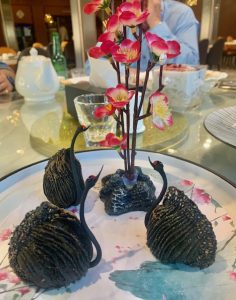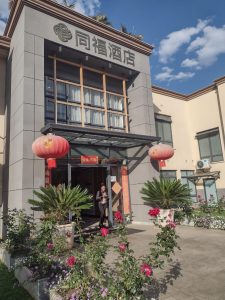

HARARE is awash with Chinese restaurants, the latest addition being the elegant Tongfu Restaurant in Phillips Avenue, Belgravia. While slow and meticulous construction of the double-storied building took place over many months, the result is a fine-dining establishment with attention to detail, stylish decor and seriously good food.
It is also said to be the largest Chinese restaurant in Africa.
A dinner of many courses in an upstairs private room was my first experience of dining at Tongfu. Invited by a connoisseur of good food, our group included some Chinese guests, who were au fait with the menu, and able to order a sumptuous selection of dishes from a menu offering hundreds of options.

Exquisite black swan pastries at Tongfu Restaurant
We were seated at a large round table, typically arranged with a personal bowl on a plate, chopsticks to the right and a teacup to the front. The plate beneath the rice bowl is meant for placement and not to be used, but I didn’t realise that at the time. To eat, one should hold up the bowl without the plate, and use the chopsticks. Mastering the art of chopsticks takes time, but if you can’t make any headway, the waiters at Tongfu can provide knives and forks.

Sophisticated decor at Tongfu Restaurant
When ordering food for a group in a Chinese restaurant, search for a harmony of contrasting elements, with a variety of tastes and textures. Thanks to our host, our meal proved to be a sensory journey combining meats, seafood and vegetables. Nothing was duplicated, and the dishes were either boiled, steamed, stewed or stir-fried. As is customary when sitting down to a Chinese meal, Chinese tea was served first, to be followed by a cold starter.
There were two attentive waiters in our private room, both so well dressed in tailored trousers, shirts and waistcoats, as to look as smart as flight attendants. Tea was poured, and the cold dishes, placed on the motorised lazy Susan, slowly made their way around the table. The stand out dish was a black fungus salad, aka wood ear mushroom salad, thus named as it grows on wood and is shaped like an ear. Seen for the first time, this dish may look slimy and unappealing, but in reality it is crunchy and fresh, with crisp zingy flavours. A hint of fresh red chilli and beautiful presentation made this a dish to eat again and again.
A delicately flavoured fish dish of sea bass was next, followed by a fiery stir-fried Kung Pao chicken. A famous dish from Sichuan province, the addictive mix of dried chilli, Sichuan pepper and peanuts, makes Kung Pao a favourite with foodies worldwide. Known as the ‘Five Fragrances’, fennel, pepper, aniseed, cinnamon and clove combine with chilli and Sichuan pepper, making hot and spicy Sichuan cuisine one of the most popular in the world.

Entrance to Tongfu Restaurant
A variety of noodles and rices followed, tempering the hot chilli, while a dish of spiced peanuts provided crunch. Pillowy soft steamed pork buns with a dipping sauce offered even more tastes and textures. Our two waiters were on point, bringing ever more dishes from the kitchen, removing empty platters and exchanging rice bowls overcrowded with chillis and the occasional bone, for new ones.
Both red and white wines were flowing, and every so often our host would raise his glass to toast everyone, calling out ‘Ganbei!’ meaning ‘dry cup’ in Chinese. Chinese drinking etiquette requires you to empty your glass without flinching, and skipping a toast is socially unacceptable.
Skilfully sculpted pineapple, water melon and apples provided a refreshing dessert, and exquisite miniature black swan pastries with crisp pastry bodies, filled with delicately flavoured duck egg custard, demonstrated the skill of the Tongfu chefs.
A week later, we joined our regular group of local foodies for Sunday lunch at Tongfu. This time we sat in the communal dining hall downstairs, and our experience was very different. While our foodie gang all have adventurous palates, my choice of sliced pig’s ear in garlic sauce proved hugely unpopular. I’m beginning to understand that ordering food at a Chinese restaurant is an art, taking time and experience; this means that a third visit to Tongfu could be in the offing.
The food-focused culture in Chinese cuisine requires balance and harmony, and a good meal should not only taste good, but also make you feel good. So choose your dishes well, and be aware of the importance of staying power when responding to Chinese drinking etiquette.
A Matter of Taste with Charlotte Malakoff
Comments to: cmalakoff@gmail.com